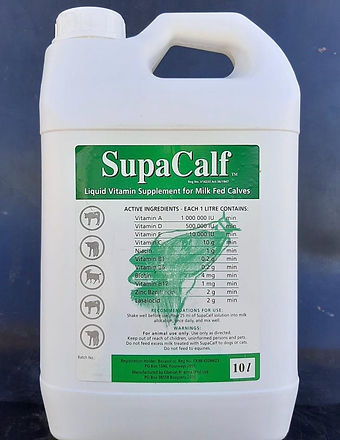Feeding Supplement

Op-staan
Cattle
Op-staan Calcium drench Reg no: V23085 Act36/1974. An aid to the prevention of calcium deficiency in farm animals. Composition: Each 1lt contains Calcium 126g min, Magnesium 6.5g min, Potassium 3.5g min, also contains vitamins B1, B2, B6 ,B12, Niacim and Propylene Glycol. Feeding recommendations: Dose at 200 - 300ml per 500kg animal, shortly before and after calving. Repeat after 3 hours if required. (Use a drench gun inserted between the teeth and cheek of the animal). Recommendation for use on: *All cows with a history of low peri-parturient calcium levels. *All high production cows. *All Jersey cows that are completing second or later parity. *All cows that fail to release their foetal membranes within 24 hours. *Can be used on all cows to stimulate feed intake. Calcium levels should be elevated between 15 and 20 minutes after administration. DO NOT USE IN COWS THAT ARE RECUMBANT AND CANNOT RAISE THEIR HEADS. Available at EC Vet Express www.ecvetexpress.co.za

SupaCalf
Cattle
SupaCalf™
Reg No V14233 Act 36 of 1947
Give your calves a head start
The Facts
Calves are most susceptible to disease and death in their first month of life
Neonatal calves are functional monogastrics
Only liquid feeds can be effectively utilised in early life
Calves do not eat sufficient dry feed by four weeks of age to protect them from protozoal infection
Protozoal infections cause scours and reduce growth rates
Clinical coccidiosis can occur in calves as young as 3 weeks old, while cryptosporidial infection can be detected from as early as 5 days of age.
Significant gut wall damage may have already occurred by the time the clinical infection is diagnosed
The Economics
Early growth is efficient growth – it pays to ensure the best utilisation of high quality and costly calf feeds
Pre-weaning growth rate has a significant effect on milk production in the first two lactations
Trials have shown that the incidence of scours in calves negatively affects the calving age of heifers. Prevention of scours helps ensure that heifers calve at an economically optimum age
Supplementing the milk or milk replacer with anti-protozoals helps protect the calf from protozoal infections in the early stages of life. This protection translates into healthier calves with improved growth rates
Improved growth rates translate into earlier age at first calving and higher first and second lactation production
The Solution
SupaCalf™ contains lasalocid for the prevention of coccidial scours during the first few weeks of life
Research has shown lasalocid to be protective against cryptosporidial infection when used at specific levels*
Lasalocid reduces oocyst shedding of both coccidia and cryptosporidia, while facilitating the development of natural immunity*
SupaCalf™ contains zinc bacitracin to assist protection against clostridial scours
Both lasalocid and zinc bacitracin are effective in increasing growth rate and feed efficiency of calves
SupaCalf™ contains essential vitamins to boost immunity, growth and health (Vit A, Vit D, Vit E, Vit C, Vit B1, Vit B6, Vit B12 niacin & biotin)
Include SupaCalf™ in the milk or milk replacer at a rate of 25 ml per calf per day for coccidiosis control, and 50ml per calf per day to assist with prevention of cryptosporidiosis
SupaCalf™ can be used as a daily oral dose in kids and lambs.
NOTE: Do not feed excess milk treated with SupaCalf™ to dogs or cats. Do not feed to equines
*Original research available upon request
